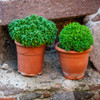Description
Spicy Globe Bush Basil - Tiny Leaves, Rich Flavors, Delightful Aroma
With your first taste of the tiny yet deliciously aromatic leaves, you’ll immediately understand why basil - or ocimum basilicum - has been regarded as the “King of Herbs” for centuries.
Also known as Greek basil, dwarf basil, or globe basil, this bush basil variety is highly versatile with multiple uses in the kitchen, around the house, and in the herb garden.
A potted basil plant growing on the landing, windowsill, or flanking the doorway as a welcome is very popular in European countries because of its petite size, bold flavors and aromas, and eye-catching appeal.
As an added benefit, globe basil tolerates lower temperatures than sweet basil, often lasting well into fall with surprisingly little protection.
Details
As with all basil, Spicy Globe basil loves a warm, sunny place to grow with damp to slightly moist soil. It is fast-growing, reaching a mature height of 6-9" in just a few weeks with a densely filled umbrella-shaped leafy canopy.
Regular harvests encourage further growth, so enjoy its rich flavors often.
History
Basil has a long history of cultivation around the world and has been used as a culinary herb, aromatic herb, and ornamental herb for centuries.
Basil is native to areas in Asia and Africa and grows wild as a perennial on some pacific islands. Alexander the Great is believed to have brought basil to Greece around 350BC where it then spread through exchange and trade to the rest of the Mediterranean region.
Europe was introduced to basil from India through the Middle East in the sixteenth century, and then on to America in the seventeenth century.
Uses
The flowering tops and seeds make a flavorful pop in salads and on sandwiches or as a unique garnish for drinks.
A pinch of leaves imparts a rich, aromatic element in sauces, pasta dishes, and scrambled eggs. Lemonade, iced tea, and many cocktails benefit from a hit of fresh basil scent and flavor.
The aroma that we love repels biting insects, making basil effective against mosquitoes, chiggers, gnats, fleas, ticks, and houseflies.
Keep a couple of pots near your front or back door and crush a few leaves to release their natural aromatic oils, then lightly rub into your skin or clothing to keep pesky biting insects at bay.
The peak flavor experience is fresh from the garden and used soon after, though it retains its unique flavors and aromas well when made into pesto and frozen. Drying is a last resort, as it loses most of the aromatic oils. But we have found that basil dried from your garden is so much more flavorful than commercial dried basil.
Companion Planting
Basil does well with asparagus and helps tomatoes overcome pest insects and disease while improving growth and flavor of both. It is best to grow the shorter basil plants alongside or parallel to the tomato plants instead of among them in their shade.
Peppers – both sweet and hot – like basil alongside them, as does beans, beets, cabbage, and eggplant. Herbs that like basil nearby are oregano and chamomile.
Basil repels mosquitoes and most flies, so keep a couple of planted pots near doorways and entrances.
Common rue and sage are antagonistic to basil, so don’t plant them near each other.
Growing Tip
When basil starts to flower, it will stop growing leaves – so pinch the flower heads off to encourage new leaf growth.
Harvest Tip
Early morning is the best time for harvesting - after the dew has dried and before the hot sun hits the plants. Cut just as the flowers are about to open, to take advantage of when the essential oils are the most abundant.
Learn More
- All About Basil
- Heirloom Basil - So Much More Than Pesto
- Easy Homemade Basil Pesto
- Fresh Heirloom Basil Recipes
From the soil to the seed to the food you eat - we'll help you grow your best garden!















